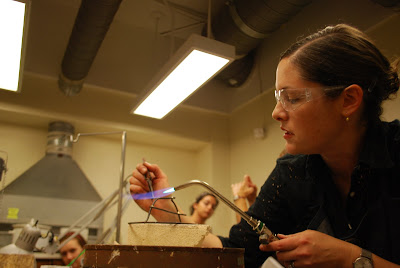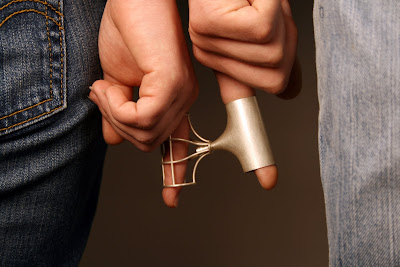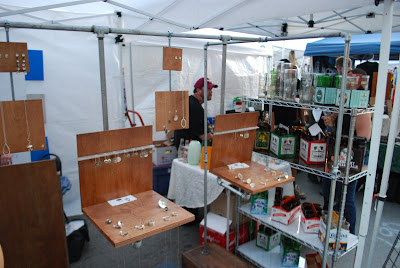What a great time we had with visiting artist, Kim Cridler. Her workshops was great and her talk was even better (as if that could even be possible?). Our little metals community really came together in the creation of the piece you see above. Each student received a section of the design and then we all came together in the creation of the whole piece in a little under five hours.
We all owe Kim a huge thank you for her inspirational talk. You can see pictures from her visit here.
This blog is intended for UWM students enrolled in Assistant Professor Frankie Flood Advanced Jewelry & Metalsmithing courses in the Jewelry & Metalsmithing area. In this course students will investigate the role of the one of kind object in a society dominated by mass produced objects and the significance of being a maker in contemporary society who works within the craft medium of metal.
Friday, September 25, 2009
Monday, September 14, 2009
Sun's work
core77 objects
It was good to talk about ideas tonight. Check out the objects below from Core77.
taken from Core77 website:
We love it when design students hold their own next to the big guys, and we're thrilled to report that the Cranbrook Academy of Art, Pratt Instituteand the Rhode Island School of Design presented stellar booths at this year's ICFF, all culminations of classes and workshops that focused on various aspects of contemporary design issues.
Hit the jump for more details on all three groups!
Cranbrook's exhibition, entitled Innate Gestures, came out of a semester long workshop, led by Scott Klinker and Leon Ransmeier, that focused on the nuance of the physical relationships between the body and the objects it interacts with, resulting in enigmatic products that demand an investigation of themselves by the user. For example, Jonathan Muecke describes his Heater as "a physical non object" and his Copper Step Stool as "an able bodied mass." Heater is tall, spatial and gently heated, inviting users to touch it, sit by it or lean against it for comfort. The Copper Step Stool is sized only for the ball of the foot, providing stability through its tripod base, and, by nature of its form, forcing the user to launch themselves upwards and only for a moment. While vague in function, the objects in this show are precise in material and character, leaving the interpretation of the interaction and use open to the user, and, in many ways, suggesting new uses, habits and spatial divisions in everyday life.
Heater by Jonathan Muecke
Step Stool by Jonathan Muecke
Tabletop Objects by Patrick Gavin
Symmetrican by Saebyul Lim
Shift Light by Hsin Chun Wang
Pratt Institute's students operated within a much more quantifiable concept: Design for a Dollar, led by Professor Mark Goetz, encouraged students to explore the design and fabrication choices available to them when working with material costs that amounted to a dollar or less. The result is a diverse and clever collection of furniture and tabletop objects that illustrate the richness and complexity that design can bring to an object, even when the material value is low. For example, in the growing tradition of contemporary decorative arts, Catherine Merrick drips wax onto second-hand ceramic plates and sandblasts away the exposed area, resulting in a new method of decoration. Equally resourcefully (but a bit more utilitarian), Brian Persico laser cuts scissor components from used sawblades, resulting in a new, sharp object with the character and history of something already discarded. The transformations represented in the objects shown by Pratt were impressive -- each designer took steps to create something new from the scant materials they chose to work with.
Drip Plate by Catherine Merrick
Scissors by Brian Persico
Lawn Sprinkler by Janelle Norton
Orange Votive Candles by David Steinvurzel
Crystal Chandelier by Jennie Maneri
An exploratory approach to materials governed the objects produced forRISD's exhibition. Immaterializing Material, taught by Lothar Windels, encouraged the students to choose an unorthodox material and conduct hands-on experiments in order to understand and make use of its properties. These investigations were then developed into the furniture and products displayed at ICFF. For example, the bubbly texture of Debra Folz's 100% Wax table comes from a manipulation of the way the wax is introduced into the mold, and, as a bonus, the whole thing can be remelted and used again. In contrast to this highly reproducible process, Andrew Mau's study of feathers led to the creation of his Perch Bowl, an unglazed ceramic bowl that is perforated with pheasant feathers, creating a soft and luxurious interior with hundreds of quills supporting the piece from its underside. The forms in this show reveal the insights discovered through the experiment of fabrication, and the hands-on approach is evident.
100% Wax by Debra Folz
Perch by Andrew Mau
Pour by Elisa Werbler
Flow by Jennifer Tran
Supple by Chelsea Frost
In conclusion, great job, guys! We laud your insights and hard work.









































